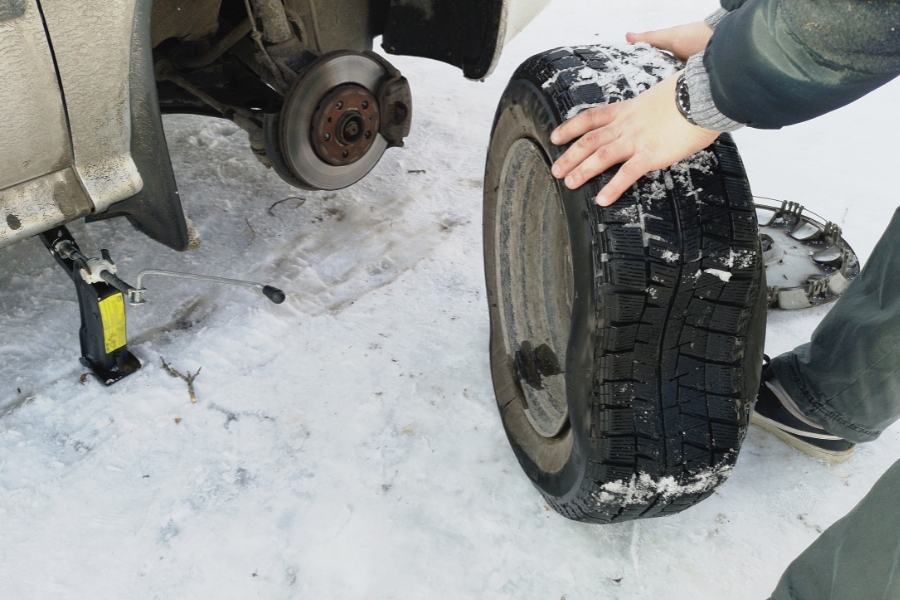Last Updated on October 9, 2024
Stay Safe on Icy Roads with Winter Tires
An increase in winter tire use would make everyone safer on the roads. A Canadian study found that universal winter tire usage was responsible for a 5-percent decline in winter road accident injuries in that country. The study also showed a 3-percent drop in deaths and serious road accident injuries.
Much of the northern U.S. has similar winter weather, and the same gains in driving safety could be realized. The widespread usage of winter tires in the north of the U.S. would have an even more significant impact because the U.S. lags far behind Canada and other countries in terms of winter tire use.
Low Winter Tire Usage in the U.S.
According to the Rubber Association of America (RMA), only 16% of drivers in the northern states use winter tires. In Germany, 40% of all vehicles are on winter tires. In Switzerland and Austria, over half the cars are equipped with winter tires. A new survey commissioned by the Tire and Rubber Association of Canada (TRAC) shows that even outside of Quebec, where winter tire usage is the law, 61 percent of Canadian drivers now use winter tires. This represents a steep increase over the last five years. In the U.S., however, the percentage has remained flat.
So, why is winter tire use so much higher and growing in other countries with similar winter weather to what we have in the northern states?
The answer is mainly related to the lack of awareness among Americans about the benefits of winter tires.

Lack of Awareness About Benefits of Winter Tires
Despite the remarkable advancements in winter tire technology, there is a significant gap in awareness regarding the invaluable benefits these specialized tires offer. Winter tires have the potential to dramatically improve safety on the roads during cold and snowy conditions, yet many individuals remain unaware of their advantages.
In this discussion, we will delve into the reasons behind this lack of awareness and underscore the importance of spreading knowledge about the benefits of winter tires to enhance winter driving safety for all.
1) Advances in Winter Tire Technology
Firstly, technical advances have improved traction performance across all tire categories, especially for winter tires. The softer tread compounds in today’s winter tires retain flexibility even in extreme cold.
At temperatures below 40 degrees Fahrenheit, winter tires provide significantly better traction. The result is much greater control and shorter stopping distances on cold roads. There have also been advances in computer modeling of tread designs, allowing for more information for designers during product development.
Tire engineers and designers can now model what would happen if they change the angle of the tread grooves or the amount of tread sipes without ever building and testing an actual tire. This modeling means new winter tires can be introduced cost-effectively, frequently, and with more significant performance improvements from one product generation to the next. Each new version of a particular winter tire will substantially gain traction and grip.
2) Communication Gap: Winter Tire Benefits
Secondly, the factor is the amount of communication about these advancements made by tire manufacturers, retailers, and government agencies. In the U.S., tire advertising is oriented more toward all-season tires, and fewer public service programs promote the benefits of winter tire use.
The result is a gap in knowledge about how much winter tires outperform all-season tires. In other countries, there has been far more advertising about winter tires and discussion in the media about the benefits of winter tire use.
In the northern states where drivers can benefit most from winter tires, people will buy winter tires if presented and aware of all the facts. The problem is that the benefits are often unclear or communicated to American tire buyers.
Understanding the Importance of Winter Tires
Winter tires, also known as snow tires, are specially designed to excel in cold weather conditions. They feature a unique rubber compound that remains flexible in low temperatures and tread patterns optimized for snow and ice traction. Here’s why they’re essential:
- Enhanced Traction: Winter tires provide better grip on snow and ice-covered roads, significantly reducing the risk of skidding or losing control of your vehicle.
- Shorter Stopping Distance: With winter tires, your vehicle can quickly halt on slippery surfaces, which can be a lifesaver in emergency braking situations.
- Improved Handling: Winter tires enhance your vehicle’s stability and cornering capabilities in adverse conditions, helping you navigate safely.
- Better Performance in Cold Temperatures: All-season and summer tires harden in cold weather, reducing effectiveness. Winter tires remain pliable, ensuring consistent performance.
- Decreased Accident Risk: Studies have shown that using winter tires during the cold season reduces accident rates. Drivers with winter tires are better prepared to handle challenging winter driving conditions.

Choosing the Right Winter Tires
Selecting the right winter tires is crucial for your safety. Here are some factors to consider:
- Tire Size: Ensure the winter tires you choose are the correct size for your vehicle. This information can be found in your vehicle’s owner’s manual or on the existing tires.
- Tread Pattern: Different winter tires have various tread patterns optimized for specific winter conditions. Consult a tire professional to select the most suitable design for your region.
- Quality Matters: Invest in quality winter tires from reputable brands. High-quality tires offer better performance and durability.
- Installation: Have your winter tires professionally installed to ensure they are balanced and aligned correctly.
Conclusion
When it comes to winter driving, safety should be your top priority. Winter tires effectively reduce accidents and enhance driver confidence during the cold season. Don’t wait until the first snowfall to make the switch. Prepare your winter tires in advance, and you’ll be well-prepared to face winter’s challenges confidently.
Tires Easy offers a wide selection of winter tires to keep you safe on winter roads. Please browse our range and make an intelligent choice for a safer winter driving experience. Don’t let winter catch you unprepared—invest in winter tires today for peace of mind and accident prevention. Stay safe out there!
FAQs
Do winter tires prevent crashes?
Winter tires significantly reduce the risk of crashes in cold and icy conditions by providing better traction and shorter stopping distances, enhancing driver control.
How effective are winter tires?
Winter tires are highly effective in temperatures below 40 degrees Fahrenheit. They offer improved grip and control on cold roads, making them a vital safety feature during winter.
What is the physics behind winter tires?
Winter tires use softer tread compounds and unique tread patterns to maintain flexibility in cold temperatures. This allows them to grip the road surface better and provide superior traction.
Why are winter tires safe?
Winter tires are safe because they are engineered to excel in winter conditions. Their advanced design and materials ensure better handling, shorter braking distances, and enhanced control, reducing the likelihood of accidents in cold and snowy weather.
-
Writer











 English
English Français
Français Español
Español